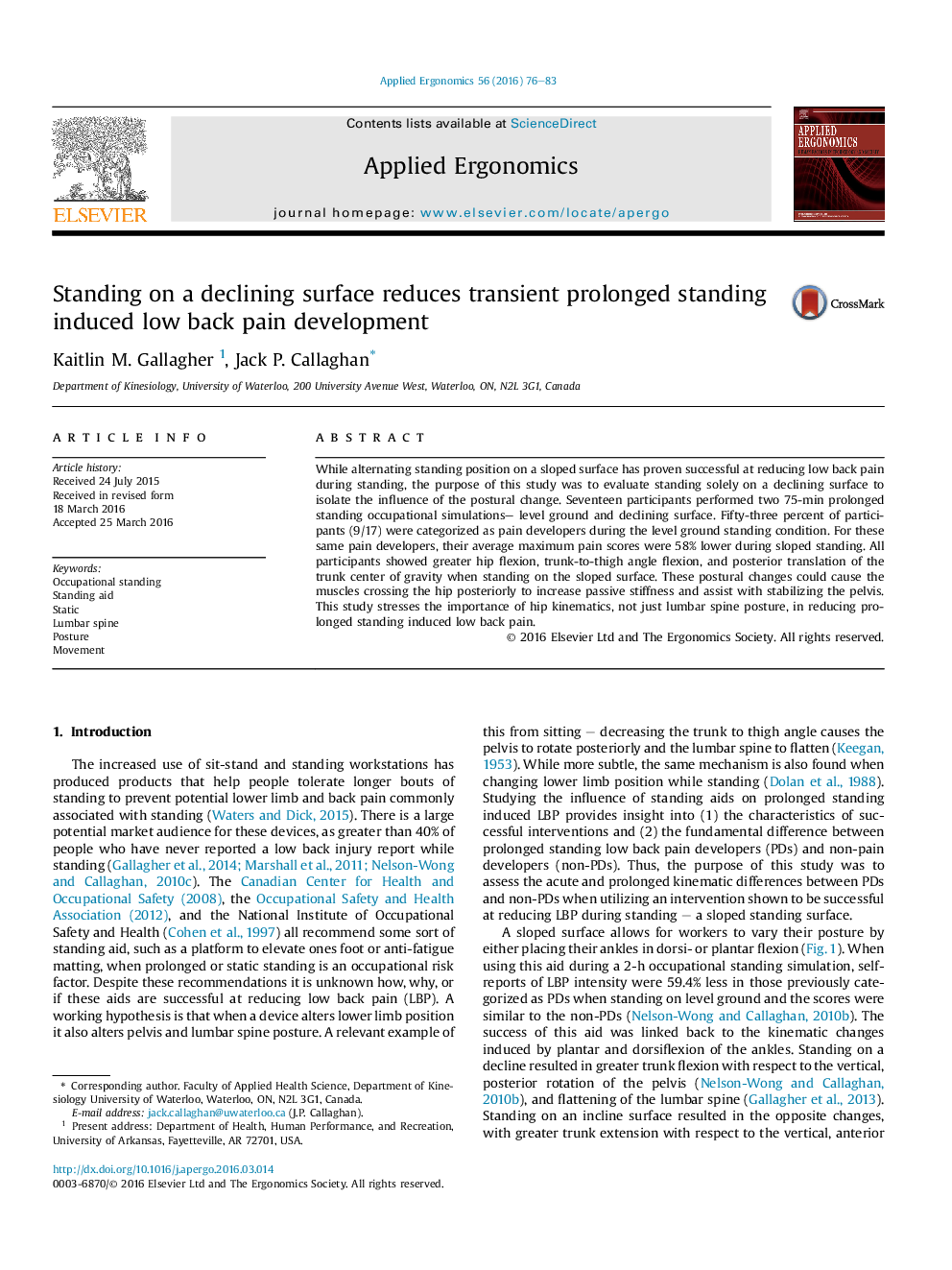| کد مقاله | کد نشریه | سال انتشار | مقاله انگلیسی | نسخه تمام متن |
|---|---|---|---|---|
| 6947800 | 1450713 | 2016 | 8 صفحه PDF | دانلود رایگان |
عنوان انگلیسی مقاله ISI
Standing on a declining surface reduces transient prolonged standing induced low back pain development
ترجمه فارسی عنوان
ایستادن در یک سطح کاهش می یابد توسعه طولانی مدت مبتلا به کمر درد ناشی از طولانی است
دانلود مقاله + سفارش ترجمه
دانلود مقاله ISI انگلیسی
رایگان برای ایرانیان
کلمات کلیدی
موقعیت شغلی، کمک دائمی، استاتیک ستون فقرات کمری، پوسیدگی، جنبش،
ترجمه چکیده
در حالی که موقعیت متناوب ایستاده در سطح شیب دار در کاهش زخم کمر درد در طول زایمان موفقیت آمیز بوده است، هدف این مطالعه، ارزیابی ایستادگی تنها روی سطح کاهش یافته است تا تاثیر تغییرات موضعی را منزوی کند. هفده شرکت کننده دو بار 75 دقیقه ای را انجام دادند؟ یک شبیه سازی شغلی طولانی مدت - سطح زمین و سطح کاهش یافته. پنجاه و سه درصد از شرکت کنندگان (17/9) به عنوان توسعه دهنده های درد در سطح ایستاده در سطح زمین طبقه بندی شدند. برای این افراد مبتلا به همان درد، میانگین نمره درد آنها در طول ایستگاه شیب دار 58٪ کمتر بود. تمام شرکت کنندگان در هنگام ایستادن بر روی سطح شیب دار، فلکشن خلط خلط، لگن زاویه دار تنه به ران و خلفی مرکز محدب گرانش را نشان دادند. این تغییرات موضعی ممکن است سبب شود که عضلات در حال حرکت به عقب به سمت پایین حرکت کنند تا سفتی غیرفعال را افزایش دهند و به ثبات لگن کمک کنند. این مطالعه بر اهمیت سینماتیک لگن، نه تنها وضعیت ستون فقرات کمری، در کاهش درد کمر درد ناشی از ایستاده طولانی است.
موضوعات مرتبط
مهندسی و علوم پایه
مهندسی کامپیوتر
تعامل انسان و کامپیوتر
چکیده انگلیسی
While alternating standing position on a sloped surface has proven successful at reducing low back pain during standing, the purpose of this study was to evaluate standing solely on a declining surface to isolate the influence of the postural change. Seventeen participants performed two 75-min prolonged standing occupational simulations- level ground and declining surface. Fifty-three percent of participants (9/17) were categorized as pain developers during the level ground standing condition. For these same pain developers, their average maximum pain scores were 58% lower during sloped standing. All participants showed greater hip flexion, trunk-to-thigh angle flexion, and posterior translation of the trunk center of gravity when standing on the sloped surface. These postural changes could cause the muscles crossing the hip posteriorly to increase passive stiffness and assist with stabilizing the pelvis. This study stresses the importance of hip kinematics, not just lumbar spine posture, in reducing prolonged standing induced low back pain.
ناشر
Database: Elsevier - ScienceDirect (ساینس دایرکت)
Journal: Applied Ergonomics - Volume 56, September 2016, Pages 76-83
Journal: Applied Ergonomics - Volume 56, September 2016, Pages 76-83
نویسندگان
Kaitlin M. Gallagher, Jack P. Callaghan,
